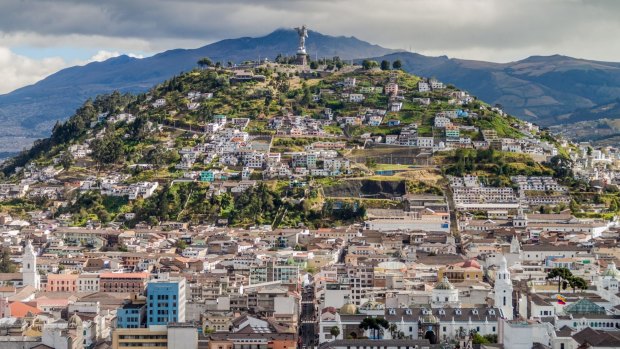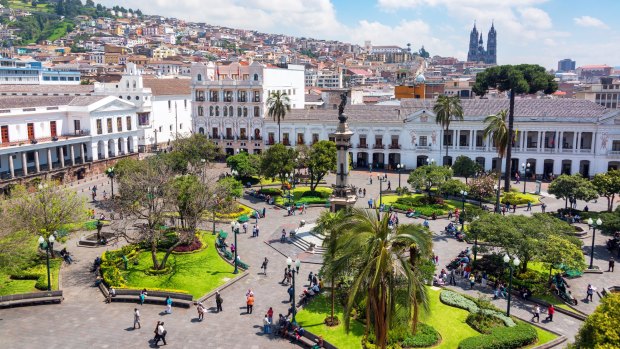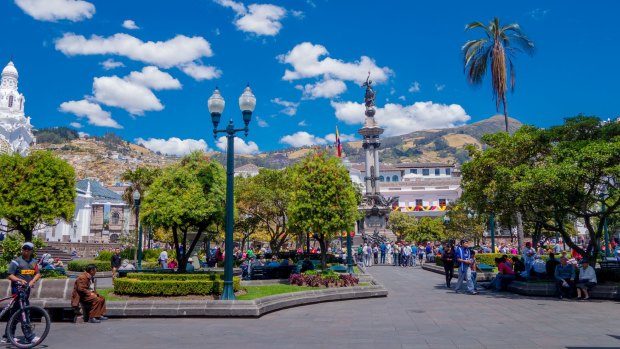This was published 6 years ago
Quito, Ecuador travel guide and things to do: Nine must-do highlights
By Julie Miller

For a great overview of the sprawling town and surrounding volcanoes, head to El Panecillo (the "Little Bread Loaf", at 3100 metres) where a towering 41-metre statue of the Virgin Mary gazes out protectively.Credit: Shutterstock
THE ONE VIEW
With a lofty elevation of 2850 metres, it's not hard to find a panorama in Quito, the second highest capital city in the world. For a great overview of the sprawling town and surrounding volcanoes, head to El Panecillo (the "Little Bread Loaf", at 3100 metres) where a towering 41-metre statue of the Virgin Mary gazes out protectively. Made from 7000 pieces of aluminium, the winged Madonna is visible from all over the city and casts an otherworldly glow at night.
THE ONE SQUARE

Plaza de la Independencia, also known as La Plaza Grande, Quito's "living room" is a great place to people-watch.Credit: Shutterstock
All roads seem to lead to Quito's largest and oldest square, Plaza de la Independencia. Also known as La Plaza Grande, Quito's "living room" is a great place to people-watch, observing the ebb and flow of local characters; during my visit, a nun, a priest and a rooster held court on the steps of the Presidential Palace, one of four monumental buildings flanking the square. Why? I never did find out.
THE ONE CHURCH
In a city of more than 200 churches – including the shimmering explosion of gold that is La Compania de Jesus – the neo-gothic Basilica del Voto Nacional stands out for one reason: its clock towers. Those who suffer from vertigo be warned – the climb to the top via a skinny plank, followed by a series of steep stairs and ladders, is only for the brave or foolish, a perilous ascent rewarded by a fabulous view across the rooftops. Who knew going to church could be so adventurous.

Independence monument, Quito.Credit: Shutterstock.com
THE ONE HOTEL
With its commanding location overlooking Plaza San Francisco, Casa Gangotena oozes historical elegance, with soaring ceilings, lavish décor and original friezes, murals and mirrors. Originally constructed in 1600, it was rebuilt in 1926 in Italianate style after a devastating fire, remaining in the hands of the influential Gangotena family until 2007, opening as a hotel in 2011. Its plush public spaces include a wood-panelled library, an interior courtyard garden complete with fountain and a fabulous panoramic terrace – the perfect location for a sunset cocktail. See casagangotena.com
THE ONE RESTAURANT
Plucking gastronomic inspiration from Ecuador's many-faceted landscapes, former NOMA chef Alejandro Chamorro and his wife, pastry whizz Piedad Salazar, showcase traditional cuisine in the kitchen of Nuema, located in the artsy Illa Experience Hotel. The ever-changing five-course tasting menu features local produce sourced direct from farmers, with unique ingredients including Andean deer, chaucha potatoes, plantains and "big ass ants", a delicacy from the Amazon region. A dining experience worth savouring. See illaexperiencehotel.com
THE ONE NEIGHBOURHOOD
Quito's bohemian heart is the pedestrian-only neighbourhood of La Ronda, a revitalised colonial strip of galleries, artisanal shops, bars and restaurants. Once the domain of artists, poets, political activists and vagabonds, it's now a lively tourist hub, particularly at night when salsa clubs throb with sweaty, sexual energy, street performers entertain the lingering throng and restaurants lure passers-by with the heady aroma of canelazo, a traditional cinnamon-infused warm cider.
THE ONE CULTURAL EXPERIENCE
In Quito's Mercado Central, one whole wall is occupied by what appears to be medical practitioners. In fact, they are curanderas – female witch doctors who heal, cleanse and conjure good fortune through traditional spells and potions. My friend, seeking true love, was made to strip to the waist; he was then whipped with sprigs of mint, lemongrass, eucalyptus and poison ivy, before being showered with Ecuadorian rose petals and coated in an oily love potion. Look for the sticky guy with welty, inflamed skin on Tinder … and swipe right.
THE ONE SNACK
Traditional helado de paila ice-cream is one of the most popular street treats in Quito, theatrically created using a copper spinning bowl, ice, salt and exotic fruits, hand-stirred to perfection. As well as delicious fruity and chocolate flavours in the non-dairy concoction, the adventurous can try tastes such as onion, ceviche, rose, tomales and my favourite – caca de perro (dog poo), made with toasted corn and black sugar.
THE ONE HAT
In one of the biggest misnomers in history, the Panana hat actually has its origins in Ecuador, based on the straw tocas worn by indigenous folk from the coast. Hand woven in long-standing family businesses, the highest quality Panama hats – determined by the translucency of fabric and fineness of weave – can cost hundreds of dollars. The top brands are Montechristi (renowned as the home of the best weavers) and Homero Ortega, which has a branch in the heart of Quito. See homeroortega.com
ONE MORE THING
Despite straddling the equator, the weather in Quito is far from steamy, due to its elevation. The average temperature is just 14 degree Celsius, with the gauge rarely tipping over 25 degrees. Pack a jacket, or use your shivering as an excuse to stock up on alpaca woollies. Nights in particular are chilly.
Julie Miller travelled as a guest of Chimu Adventures
Sign up for the Traveller Deals newsletter
Get exclusive travel deals delivered straight to your inbox. Sign up now.